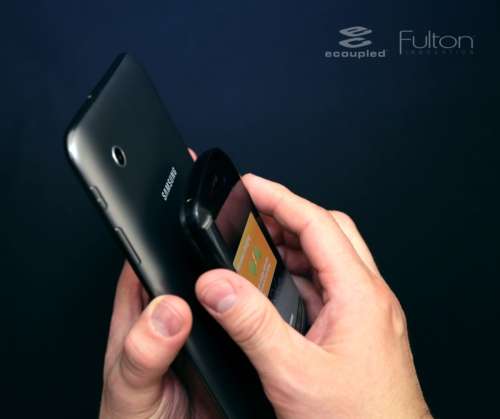(Phys.org)—Instead of sharing the pain of how your phone is dead why not share the charge. That is the suggestion posed this week at the CES in Las Vegas among those behind Fulton Innovation's featured technology, which allows for device-to-device wireless charging. Fulton's team are offering a solution where a smartphone and tablet, for example, can just transfer power from one to the other. Michigan-based Fulton Innovation, manufacturers of eCoupled wireless chargers, demonstrated the charging technology this week at the show.
The company's two-way wireless power approach will be introduced to the Wireless Power Consortium, which is the group that developed the wireless standard Qi. The Consortium was set up in 2008 as an open membership group of Asian, American, and European companies. The consortium's mission is promoting wide marketplace adoption of Qi. The Qi is the global, interoperable wireless power standard created to work across rechargeable devices.
Fulton Innovation's technology is licensed globally across industries, according to the company site. The company is represented by a team of scientists, engineers, and business people sharing a vision of seeing more devices compatible with Qi wireless charging. The two-way power transfer was for demonstration at CES but time will tell how soon equipment manufacturers license the two-way technology to build it into their mobile devices. When that happens, devices using Qi will play well into the market needs of users who carry multiple mobile devices as well as those who would welcome the idea of being able to share device charges with friends or co-workers.
By placing two Qi-enabled devices back-to-back, a tablet charged up a phone at the show. Other than preventing a dead phone, another scenario would be a tablet user wanting to extend the power of the mobile device to finish work under way and pulling extra power, to make sure the work gets done, from a smartphone.
Wireless power solutions have been the focal point of the company for some years. With the rise in mobile computing, how easily people can interact with wireless power is as key as how people interact with networking. A white paper in past years by David Baarman, a company director, "The Need for a Universal Wireless Power Solution," said that "it is now up to the companies interested in developing and manufacturing these solutions to develop a standard that will allow consumers around the world to power their devices across a broad range of brands and power needs under a single, interoperable standard."
© 2013 Phys.org























